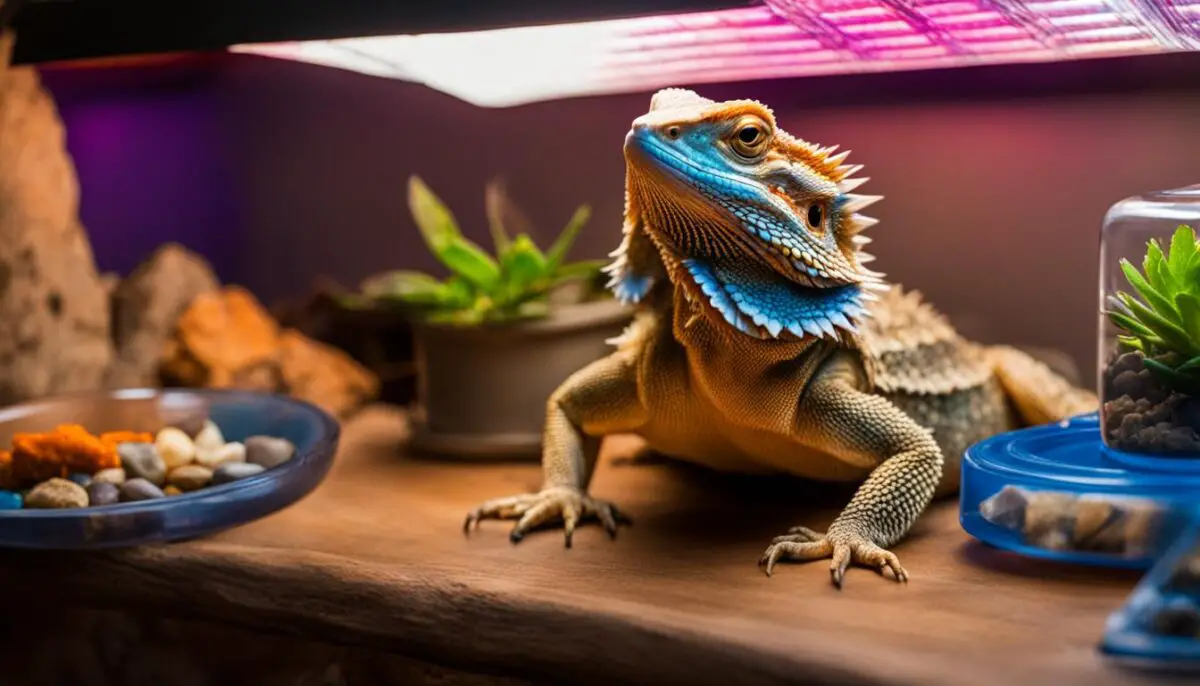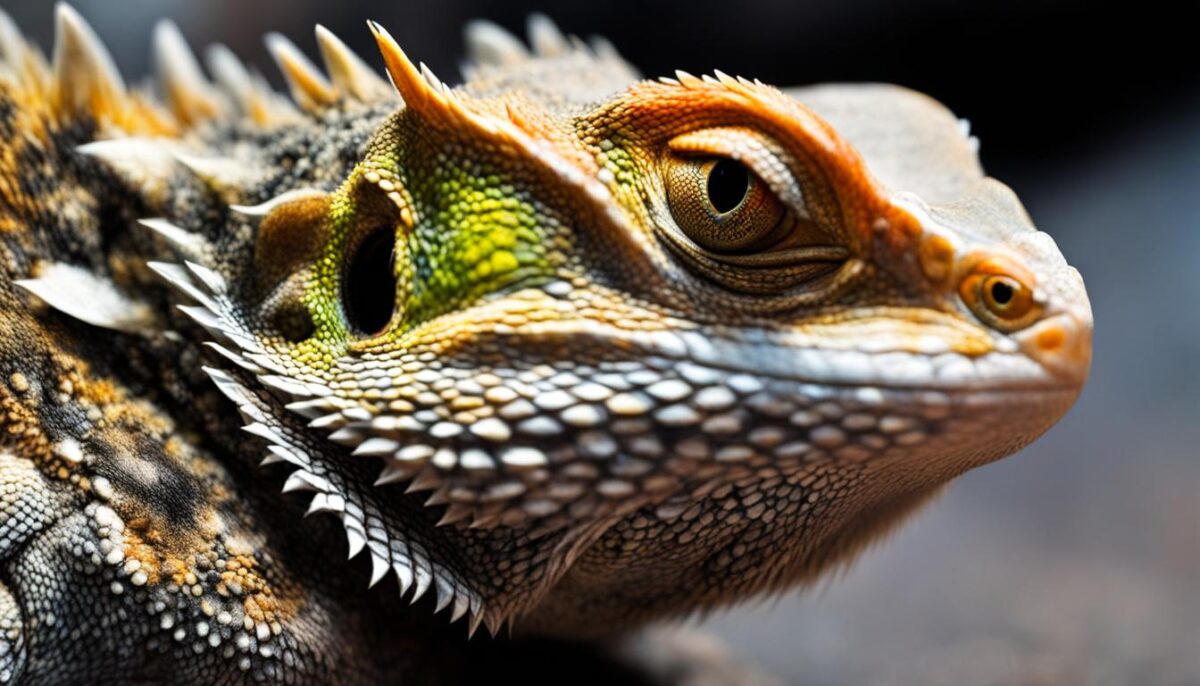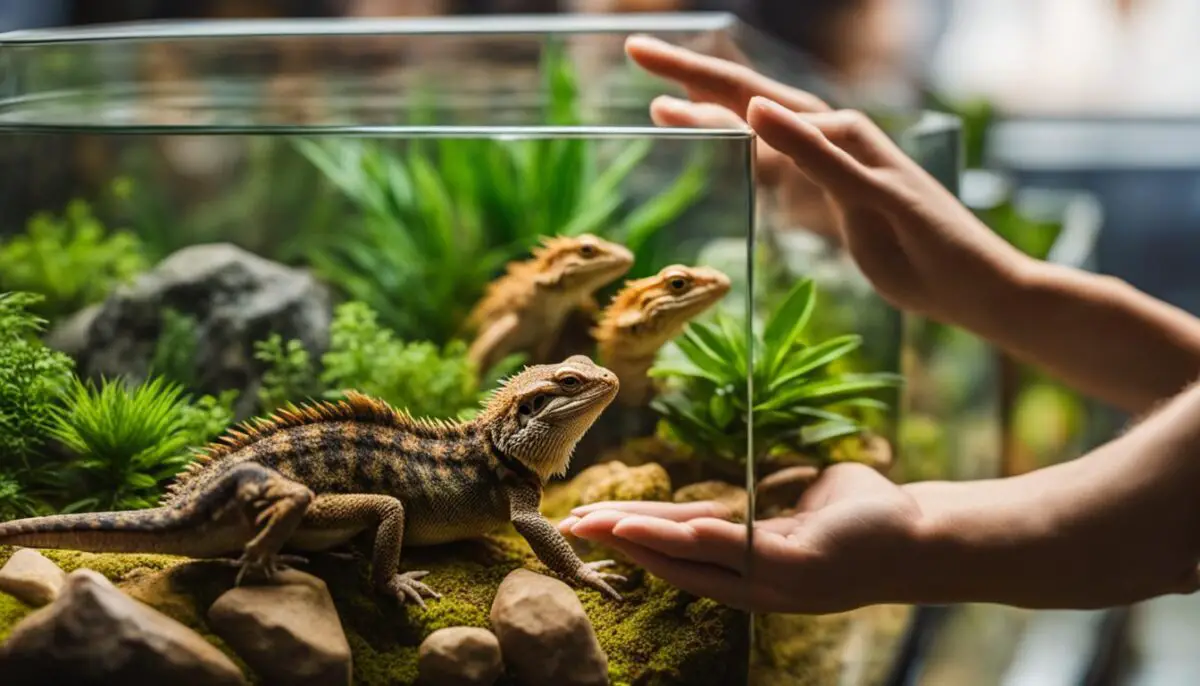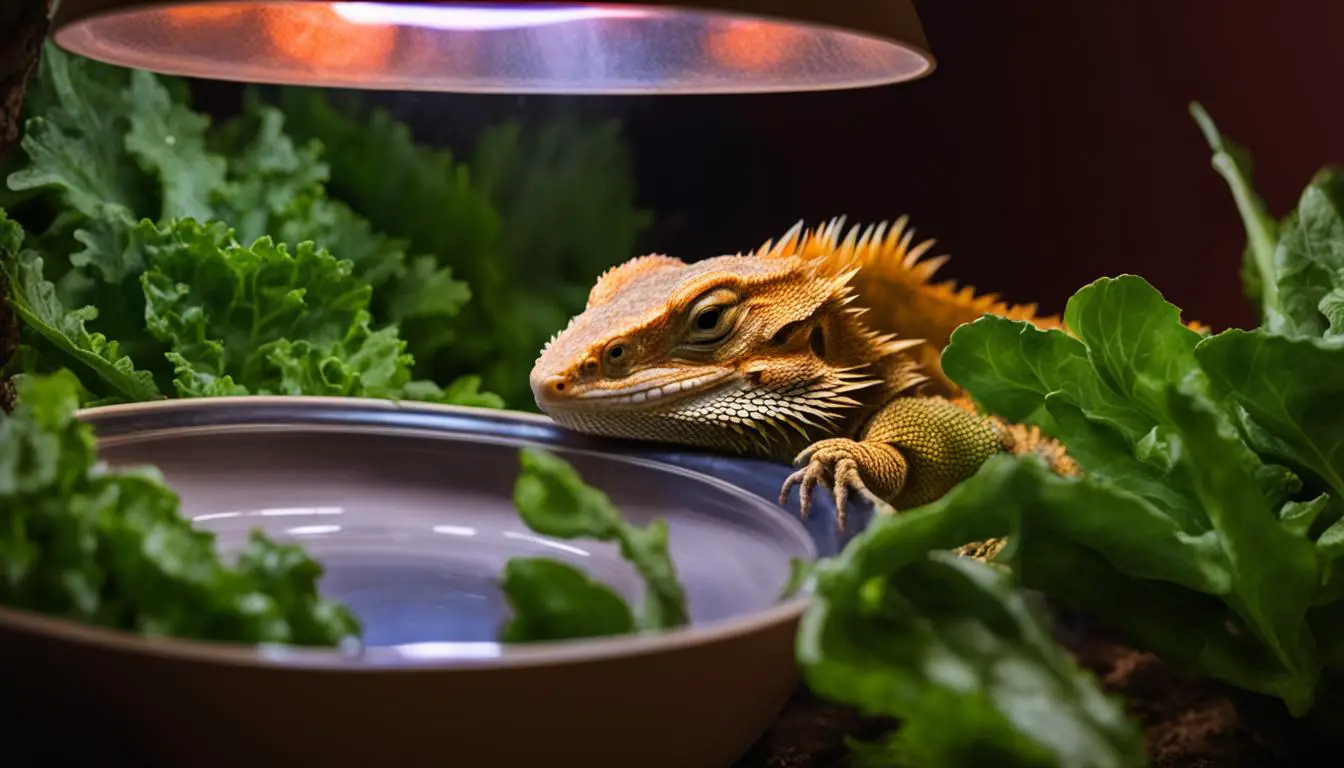Welcome to Bearded Dragon On, your ultimate guide to caring for these fascinating reptiles. Whether you’re a new or experienced reptile owner, this comprehensive guide will provide you with all the information you need to ensure the well-being and happiness of your bearded dragon. From their unique appearance and origin to their dietary needs and health concerns, we’ve got you covered. So let’s dive into the world of bearded dragons and discover the joys of pet reptile care!
Key Takeaways:
- Bearded Dragons are native to Australia and are known for their spiny scales and unique skin colors and patterns.
- They are diurnal creatures that require extreme heat and light to thrive.
- Their diet consists of insects, fruit, greens, vegetables, and flowers.
- Bearded Dragons make great pets due to their docile nature, adaptability, and relatively low maintenance.
- Proper care includes providing a suitable habitat, a balanced diet, and regular vet check-ups.
Appearance and Origin
Bearded Dragons are named after the beard-like, spiky collars around their throats. They come in various skin colors and patterns, making them visually striking reptiles. The Central or Inland Bearded Dragon, scientifically known as Pogona vitticeps, is the most recognized species. These fascinating creatures are native to Australia and can be found in diverse environments such as sub-tropical regions, ocean shores, woodlands, and shrublands.
Bearded Dragons have a unique adaptation to their cold-blooded nature. They regulate their body temperature by basking in the sun during the day, which provides them with the necessary heat to function optimally. However, they also seek out underground burrows for rest and sleep, creating a balance between temperature regulation and protection from extreme conditions.
Distinctive Features
One of the most notable characteristics of Bearded Dragons is the collar of spiny scales around their throats. This beard-like feature can change color, and when fully extended, it serves as a means of communication as well as a defense mechanism. Bearded Dragons also have a variety of skin colors and patterns, ranging from earthy tones like brown and tan to vibrant hues such as red, orange, and yellow. These unique physical attributes contribute to their popularity as pets.
| Distinctive Features of Bearded Dragons | Description |
|---|---|
| Spiny Collar | Bearded Dragons have a beard of spiny scales around their throats, which they can extend or darken to communicate or show aggression. |
| Variable Skin Colors | Bearded Dragons come in a range of colors, including shades of brown, tan, red, orange, and yellow, with unique patterns and markings. |
| Heat Regulation | These reptiles bask in the sun to absorb heat during the day and seek shelter in underground burrows to regulate their body temperature. |
Why Do Bearded Dragons Make Good Pets?
Bearded Dragons are beloved pets for several reasons. First and foremost, they are relatively easy to care for compared to other reptiles. They have a docile nature and are known to interact well with humans, making them great companions. Their omnivorous diet allows for a variety of feeding options, including insects, greens, and vegetables. Additionally, Bearded Dragons can adapt to different house sizes, making them suitable for both small apartments and larger homes.
Another advantage of owning a Bearded Dragon is their long lifespan. With proper care, they can live up to 10 years or more, providing many years of joy and companionship. Furthermore, compared to other pets, Bearded Dragons are generally inexpensive to set up and maintain. Their initial setup costs, such as tanks and accessories, can be affordable, and their ongoing expenses, such as food and medical care, are minimal.
Overall, Bearded Dragons make excellent pets due to their easy care requirements, friendly nature, adaptability, and affordability. Whether you’re a reptile enthusiast or a first-time pet owner, a Bearded Dragon can be a fantastic addition to your family.
Bearded Dragon Characteristics
- Docile nature and friendly temperament
- Ability to interact well with humans
- Omnivorous diet allows for variety in feeding options
- Adaptable to different house sizes
- Long lifespan with proper care
- Relatively inexpensive to set up and maintain
When considering a pet reptile, the unique characteristics and advantages of Bearded Dragons make them a popular choice among enthusiasts and beginners alike.
| Advantages | Considerations |
|---|---|
| Easy to care for compared to other reptiles | Requiring a properly sized and equipped tank |
| Docile nature and ability to interact well with humans | Regular cleaning of the tank and maintaining proper temperature and lighting |
| Omnivorous diet with a variety of feeding options | Providing a balanced diet and regular supplementation |
| Adaptable to different house sizes | Ensuring a suitable environment with proper temperature gradients |
| Long lifespan with proper care | Regular vet check-ups and monitoring for any signs of illness |
| Relatively inexpensive to set up and maintain | Regular expenses for food and occasional medical care |
With their unique characteristics and advantages, Bearded Dragons are fascinating pets that can provide years of joy and companionship. Their easy care requirements, friendly nature, adaptability, and affordability make them a popular choice for reptile enthusiasts and pet owners of all experience levels.
15 Fun Facts About Bearded Dragons
Bearded Dragons are fascinating creatures with unique features and behaviors that make them a delight for reptile enthusiasts. Here are 15 fun facts about these captivating reptiles:
- Bearded Dragons have a third eye called a parietal eye on their foreheads. Although it doesn’t provide detailed vision, it can sense changes in light and detect predators from above.
- They can change their skin colors and patterns after shedding. This process, known as ecdysis, allows them to adapt to their surroundings and may be influenced by factors such as stress and temperature.
- Bearded Dragons can sleep standing up by locking their knees, which helps keep them balanced and secure while resting.
- They have a unique way of showing dominance called “bearding.” When threatened or asserting dominance, a Bearded Dragon will puff out its beard, making it appear larger and more intimidating.
- Bearded Dragons are capable of running at a speed of up to 9 miles per hour, making them quite agile for reptiles.
- They have a specialized gland located on the underside of their chin called the “femoral pore.” This gland secretes a waxy substance that contains pheromones and is used for marking territory and attracting mates.
- Bearded Dragons can collect water through a process called “capillary action.” They absorb water through the spongy area around their mouths, allowing them to drink without requiring a water source.
- They are social creatures and can develop strong bonds with their owners. Bearded Dragons enjoy human interaction and can become quite affectionate with regular handling and attention.
- Bearded Dragons have a unique defense mechanism called “tail autotomy.” If they feel threatened, they can voluntarily detach their tails to distract predators while they make their escape. The tail will eventually regenerate, but it may not have the same fullness and coloration as the original.
- They have sharp claws and can climb trees, rocks, and other structures with ease. This natural climbing ability allows them to explore their environment and find optimal basking spots.
These fun facts about Bearded Dragons showcase their adaptability, intelligence, and distinctive characteristics. They are truly remarkable reptiles that continue to capture the hearts of pet owners and enthusiasts alike.
Interesting Quote:
“Bearded Dragons are like little dinosaur companions. Their unique behaviors and features never cease to amaze me.” – Reptile Enthusiast
Bearded Dragon Care Costs
Owning a bearded dragon comes with various expenses. From setting up their enclosure to providing proper lighting and heating, these costs should be taken into consideration when deciding to bring a bearded dragon into your home.
The initial setup of a bearded dragon enclosure can range in cost depending on the size and accessories. A basic tank setup can cost around $150, while a larger and more elaborate setup can cost up to $500. This includes the cost of the tank, substrate, decorations, and basking branches.
One of the essential aspects of bearded dragon care is providing the right lighting. A basking light and UVB bulb are necessary to simulate their natural habitat and support their overall health. These bulbs can range in price from $20 to $50 each, and they need to be replaced periodically to maintain their effectiveness.
Aside from the setup costs, ongoing expenses include food and supplements. Bearded dragons require a varied diet that consists of insects, leafy greens, and other vegetables. The cost of insects can add up depending on the size and appetite of your dragon. Additionally, calcium and vitamin supplements are important to ensure their nutritional needs are met.
In summary, while the initial cost of setting up a bearded dragon’s enclosure and providing the necessary lighting can be an investment, the ongoing costs of bearded dragon care are relatively affordable. With proper planning and budgeting, you can provide your bearded dragon with a comfortable and healthy environment.
| Expense | Estimated Cost |
|---|---|
| Enclosure Setup (tank, substrate, decorations) | $150 – $500 |
| Basking Light | $20 – $50 |
| UVB Bulb | $20 – $50 |
| Insects (food) | Varies depending on quantity and size |
| Leafy Greens and Vegetables (food) | Varies depending on quantity and availability |
| Calcium and Vitamin Supplements | $10 – $20 |
It’s important to note that these cost estimates are approximate and can vary depending on your location and individual preferences. Additionally, unexpected veterinary expenses may arise if your bearded dragon experiences health issues.
Despite these costs, many bearded dragon owners find that the joy and companionship provided by these reptiles make the investment worthwhile. With proper care and attention, your bearded dragon can live a long and healthy life.

Cage Setup and Environmental Needs
Proper cage setup and meeting the environmental needs of your bearded dragon are essential for their overall health and well-being. Creating a suitable habitat for your pet reptile involves providing the right type of enclosure, temperature gradient, lighting, and humidity levels.
Enclosure
A glass or plexiglass aquarium or terrarium is recommended for housing your bearded dragon. The size of the enclosure should be appropriate for the size of your dragon, allowing them enough space to move around comfortably. It’s important to include basking branches, rocks, and hiding spots to mimic their natural habitat and provide enrichment.
Temperature Requirements
Bearded dragons are ectothermic, which means they rely on external heat sources to regulate their body temperature. Maintaining a proper temperature gradient is crucial for their health. The basking spot should have a temperature between 95 and 105 degrees Fahrenheit (35-40 degrees Celsius), allowing them to thermoregulate effectively. The cooler side of the enclosure should be around 80 degrees Fahrenheit (27 degrees Celsius) to provide a comfortable resting area.
Lighting and Humidity
UV lighting is essential for bearded dragons as it helps them synthesize vitamin D3, which is crucial for calcium absorption. Ensure your dragon has access to both UVA and UVB rays by using a suitable reptile lamp. Additionally, maintaining a consistent day-night cycle is important for their biological rhythms. Bearded dragons also require a relatively low humidity level of around 30-40%, which can be achieved by providing proper ventilation and avoiding excessive misting.
| Environmental Needs | Requirements |
|---|---|
| Enclosure Type | Glass or plexiglass aquarium or terrarium |
| Temperature Gradient | Basking spot: 95-105°F (35-40°C) Cool side: 80°F (27°C) |
| Lighting | UVB and UVA rays Consistent day-night cycle |
| Humidity | 30-40% |
Providing the right cage setup and meeting the environmental needs of your bearded dragon will contribute to their overall health, happiness, and longevity. Remember to regularly monitor and adjust the temperature, lighting, and humidity levels to ensure optimal conditions for your pet reptile.
Feeding and Diet
Proper nutrition is crucial for the health and well-being of your bearded dragon. A balanced diet consists of a variety of insects, leafy greens, and other vegetables. Offering a diverse range of foods ensures your dragon receives the necessary nutrients for optimal growth and vitality.
When it comes to feeding your bearded dragon, it’s important to establish a feeding schedule. While adult dragons can be fed once every 24 hours, baby dragons require more frequent feedings, typically two to three times a day. Adjust the feeding frequency as your dragon grows and matures.
For the insect component of their diet, you can provide crickets, mealworms, dubia roaches, and other appropriate-sized insects. Dusting the insects with calcium and vitamin supplements before feeding them to your dragon helps meet their nutritional requirements. Leafy greens such as collard greens, mustard greens, and dandelion greens should make up a significant portion of their vegetable intake. Other vegetables like carrots, bell peppers, and squash can be offered in moderation. It’s important to thoroughly wash all fruits and vegetables before feeding them to your dragon to remove any pesticides or harmful chemicals.

Metabolic Bone Disease
Metabolic Bone Disease (MBD) is a common health problem in bearded dragons. It is caused by a deficiency of calcium, vitamin D3, or both. MBD results in weak and brittle bones, which can lead to fractures and deformities. Common symptoms of MBD include tremors, lethargy, weakness, swollen limbs, and difficulty walking. To prevent MBD, it’s crucial to provide your bearded dragon with a balanced diet rich in calcium and ensure they receive adequate exposure to UVB lighting.
Respiratory Infections
Respiratory infections are another common health concern among bearded dragons. These infections can be caused by bacteria, viruses, or fungi and can result from poor husbandry practices or exposure to cold temperatures. Symptoms of respiratory infections include wheezing, labored breathing, nasal discharge, and loss of appetite. If you suspect your bearded dragon has a respiratory infection, it’s important to seek veterinary care promptly to prevent further complications.
Impaction
Impaction occurs when a bearded dragon ingests a foreign object that becomes lodged in its digestive system. Common culprits of impaction include loose substrate, such as sand or gravel, as well as inappropriate food items that are too large to be properly digested. Signs of impaction include loss of appetite, lethargy, bloating, and difficulty passing stool. To prevent impaction, it’s vital to provide your bearded dragon with a suitable substrate and feed them appropriately sized prey items.
Regular veterinary check-ups and proactive monitoring of your bearded dragon’s health are crucial for preventing and addressing these common health concerns. By providing a proper diet, maintaining suitable habitat conditions, and seeking professional care when needed, you can help ensure your bearded dragon lives a healthy and fulfilling life.
Gender Differences and Breeding
Bearded dragons exhibit distinct gender differences in both physical traits and behavior. These differences can provide important insights into their reproductive behavior and requirements. Understanding these gender characteristics is crucial for those interested in breeding bearded dragons or simply wanting to identify the gender of their pet.
One of the most obvious gender differences in bearded dragons is their size. Males tend to be larger and bulkier compared to females. Adult male dragons also develop a series of dark, spiky pores under their hind legs and along their femoral ridge. These pores release a waxy substance believed to play a role in scent marking and territorial behavior.
Another noticeable difference is the presence of pre-anal pores. These small, round openings are found on the underside of male bearded dragons between their hind legs. They are absent in females. These pores also play a role in the release of pheromones and are more prominent during the breeding season.
To determine the gender of a bearded dragon, additional cues can be observed. Males typically exhibit more aggressive behavior and head-bobbing displays, especially when competing for the attention of females. Females, on the other hand, may display digging behavior when ready to lay eggs. It’s important to note that gender identification can be challenging in juvenile dragons and may require the expertise of a reptile veterinarian or experienced breeder.
Gender Differences in Bearded Dragons:
| Physical Characteristics | Male | Female |
|---|---|---|
| Size | Larger and bulkier | Smaller and leaner |
| Pre-anal Pores | Present | Absent |
| Coloration | More vibrant | Less vibrant |
| Head-bobbing | More frequent | Rarely observed |
| Aggression | More aggressive | Less aggressive |
| Scent-marking Behavior | Prominent | Not observed |
Note: Gender differences may vary among individual dragons. Consult with a reptile veterinarian or experienced breeder for accurate gender identification.
Choosing and Acquiring a Bearded Dragon
When it comes to choosing a bearded dragon as a pet, there are a few key factors to consider. First and foremost, it’s important to select a healthy individual with active behavior and healthy skin. Look for dragons that are alert, have bright eyes, and show no signs of illness or injury. Check for clear nostrils and a clean vent area, as these can indicate overall health and hygiene.
Reputable breeders or rescue organizations are good sources for acquiring bearded dragons. They can provide valuable information about the dragon’s background, genetics, and care requirements. Additionally, these sources often prioritize the well-being of the dragons and can offer guidance on the proper handling and care of your new pet.
Transporting a bearded dragon requires special care to ensure their safety and well-being. Make sure to provide a secure and appropriately sized carrier that allows for proper ventilation. Avoid sudden temperature changes, and provide a warm and comfortable environment during transportation. Once you bring your dragon home, it’s essential to allow them time to acclimate to their new environment gradually. Provide a suitable habitat with proper lighting, temperature, and hiding spots to help them feel safe and secure.
| Choosing and Acquiring a Bearded Dragon | Considerations |
|---|---|
| Source | Reputable breeders or rescue organizations. |
| Health | Active behavior, healthy skin, clear nostrils, and clean vent area. |
| Transportation | Secure carrier with proper ventilation and a warm environment. |
| Acclimation | Provide a suitable habitat and allow gradual adjustment. |

“Choosing the right bearded dragon is crucial in providing a healthy and happy life for your new pet. Consider the dragon’s source, health, and transportation needs to ensure a smooth transition. With patience and proper care, your bearded dragon will become a beloved member of your family.”
By following these guidelines and conducting thorough research, you can make an informed decision when choosing and acquiring a bearded dragon. Remember, responsible ownership includes providing a suitable habitat, proper nutrition, and regular veterinary care to ensure the well-being of your new reptilian friend. Building a strong bond with your bearded dragon starts with providing a safe and nurturing environment in which they can thrive.
Bearded Dragon Fun Facts
Bearded dragons are fascinating creatures with unique characteristics and behaviors that make them stand out among reptiles. Here are some interesting facts about bearded dragons:
- Third Eye: Bearded dragons have a third eye on their foreheads called a parietal eye. This eye is not used for vision but helps them detect changes in light and shadow, allowing them to stay alert and aware of their surroundings.
- Sleeping Standing Up: Unlike most animals, bearded dragons have the ability to sleep while standing up. They can lock their knees, which allows them to rest without needing to lie down.
- Water Collection: Bearded dragons have a unique way of collecting water. They absorb water through the skin on their lower abdomen and tail by sitting in shallow water or walking through wet areas. This adaptation helps them stay hydrated in their arid natural habitats.
- Color Change: Bearded dragons can change their colors and patterns, especially after shedding their old skin. This ability allows them to adapt to their surroundings and regulate their body temperature by absorbing or reflecting sunlight as needed.
These fun facts about bearded dragons highlight their remarkable features and behaviors, making them intriguing and delightful pets to own. Understanding these facts can deepen the bond between the owner and the bearded dragon, fostering a greater appreciation for these incredible creatures.
| Fact | Description |
|---|---|
| Third Eye | Bearded dragons have a third eye on their foreheads called a parietal eye, which helps them detect changes in light and shadow. |
| Sleeping Standing Up | Unlike most animals, bearded dragons can sleep while standing up by locking their knees. |
| Water Collection | Bearded dragons absorb water through their lower abdomen and tail by sitting in shallow water or walking through wet areas. |
| Color Change | Bearded dragons can change their colors and patterns, especially after shedding their old skin, to adapt to their surroundings. |
https://seo-writing.ai/32_6.png
Conclusion
In conclusion, caring for a bearded dragon can be a rewarding and fulfilling experience. These captivating reptile pets bring joy and companionship to their owners. By providing the proper care, habitat setup, and diet, you can ensure that your bearded dragon thrives and lives a long and healthy life.
Remember, owning a bearded dragon requires commitment and responsibility. But the unique behaviors and presence of these remarkable creatures make it all worth it.
This comprehensive care guide has provided you with essential information for bearded dragon owners and those considering getting a bearded dragon as a pet. With the right knowledge and understanding, you can create a happy and harmonious environment for your beloved bearded dragon.
FAQ
Are bearded dragons good pets for beginners?
Yes, bearded dragons are relatively easy to care for compared to other reptiles, making them a great choice for beginners.
What do bearded dragons eat?
Bearded dragons are omnivorous and require a balanced diet of insects, fruits, vegetables, and greens.
How much does it cost to care for a bearded dragon?
The cost of caring for a bearded dragon can vary, but the initial setup and ongoing expenses are relatively low compared to other pets.
How big of a tank does a bearded dragon need?
The size of the tank should be appropriate for the size of the bearded dragon, and it should provide enough space for them to move around comfortably.
What temperature do bearded dragons need in their tank?
Bearded dragons require a basking spot temperature of 95 to 105 degrees Fahrenheit and a temperature gradient in their tank.
Can bearded dragons change their colors and patterns?
Yes, bearded dragons can change their colors and patterns after shedding, which is a natural process for them.
What are the common health concerns for bearded dragons?
Bearded dragons can be susceptible to metabolic bone disease, respiratory infections, and impaction of the digestive system.
How can I tell the gender of a bearded dragon?
Determining the gender of a bearded dragon can be challenging, but there are specific traits and behaviors that can help determine it.
Where can I get a bearded dragon?
Reputable breeders or rescue organizations are good sources for acquiring bearded dragons.
What are some fun facts about bearded dragons?
Bearded dragons have a third eye on their foreheads, can sleep standing up, and have interesting ways of collecting water.


